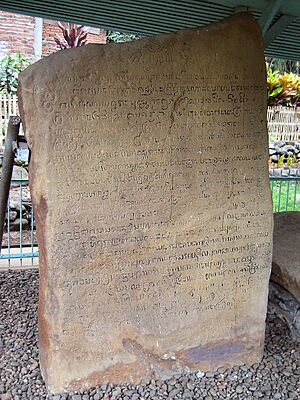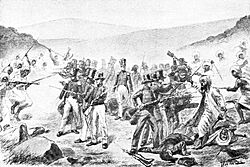Pagaruyung Kingdom facts for kids
Quick facts for kids
Malayapura
ملاياڤورا Pagaruyung Dārul Qarār
ڤݢرويڠ دار القرار |
|||||||||||
|---|---|---|---|---|---|---|---|---|---|---|---|
| 1347–1833 | |||||||||||
 |
|||||||||||
| Capital | Pagaruyung | ||||||||||
| Common languages | Sanskrit, Minang, and Malay | ||||||||||
| Religion | Hindu-Buddhism (first era), Animism, Sunni Islam (last era) | ||||||||||
| Government | Monarchy | ||||||||||
| Maharaja Diraja | |||||||||||
|
• 1347–1375
(First King) |
Adityawarman | ||||||||||
|
• 1789–1833
Last King) |
Sultan Tangkal Alam | ||||||||||
| History | |||||||||||
|
• Established
|
1347 | ||||||||||
|
• Padri War
|
1833 | ||||||||||
|
|||||||||||
| Today part of | Indonesia | ||||||||||
Pagaruyung (Minangkabau: Karajaan Pagaruyuang) was an old kingdom on the island of Sumatra, where the Minangkabau people lived. It was also known as Pagaruyung Dārul Qarār or Malayapura. Today, Pagaruyung is a village near Batusangkar, Indonesia.
Before Pagaruyung became a kingdom, it was part of a larger area called Malayapura. This area was ruled by a king named Adityawarman. He became the ruler of Bhumi Malayu in Suwarnabhumi (which means 'Land of Gold'). Malayapura also included the kingdom of Dharmasraya and other lands that Adityawarman had taken control of.
Contents
What's in a Name?
The name Pagaruyung comes from the Minangkabau word for the Nibung or Ruyung tree. It might also refer to a special stamp used by Sultan Tangkal Alam Bagagar, a king of Pagaruyung. This stamp had writing in Jawi script that mentioned "Pagaruyung Dārul Qarār."
The Pagaruyung Kingdom ended during a war called the Padri War. This happened after an agreement was signed between the local people and the Dutch, which put the kingdom under Dutch rule.
History of Pagaruyung
How the Kingdom Started

It's not fully clear when Pagaruyung began as a kingdom. Some old stories of the Minangkabau people, called Tambo, don't give exact dates. However, writings left by Adityawarman show that he was a king in this land. People believe Adityawarman started the kingdom and ruled central Sumatra from 1347 to 1375. He likely wanted to control the trade of gold in the area.
Some old items from Adityawarman's time have been found, like inscribed stones and statues. Many of these were found near modern Pagaruyung, suggesting a royal palace was once there.
In 1347, Adityawarman declared himself king in Malayapura. He was the son of Dara Jingga, a princess from the Dharmasraya Kingdom. Adityawarman had also fought alongside a famous general named Gajah Mada to conquer other areas. It's thought that Adityawarman moved his government to the Minangkabau heartland.
An old writing called the Prasasti Saruaso I mentions Adityawarman finishing an irrigation ditch. This ditch helped water the rice fields. It was started by his uncle, Akarendrawarman, who was the king before him. This shows that the Minangkabau custom of inheritance from uncle to nephew was already happening.
Adityawarman was first sent to Sumatra to control important areas. He was a king who served a larger empire called Majapahit. But Adityawarman also sent messengers to China several times between 1371 and 1377.
After Adityawarman died, Majapahit might have tried to take over the kingdom again in 1409. Minangkabau stories tell of a big battle where the Javanese army was defeated. Before the kingdom was formed, the Minangkabau people already had a system where different villages worked together. The Pagaruyung kingdom then became a new way of organizing the local people.
Early Religions: Hindu and Buddhist
Hindu and Buddhist beliefs became important in central Sumatra around the 13th century. This started with an expedition sent by Kertanegara of Singhasari. Later, during the time of Adityawarman and his son Ananggawarman, these religions were strong. Adityawarman was powerful enough to rule central Sumatra and the areas around it. He used the title Maharajadiraja, which means 'Great King of Kings'.
An old stone writing, the Saruaso II inscription, says that Ananggawarman performed a special Buddhist ceremony. This ceremony was to pass power from Adityawarman to his son. Some areas in central Sumatra still have signs of Buddhist influence, like the Muara Takus temple.
The Rise of Islam
Islam began to spread in Pagaruyung around the 16th century. Travelers and religious teachers from places like Aceh and Malacca brought the new faith. A famous teacher named Syaikh Burhanuddin Ulakan is believed to be the first to spread Islam in Pagaruyung. By the 17th century, the Pagaruyung Kingdom became an Islamic sultanate. The first Islamic king is known in Minangkabau stories as Sultan Alif.
When Islam arrived, some old customs that went against Islamic teachings were changed. The important parts of Minangkabau custom were then based on Islamic rules. A famous Minangkabau saying is: "Adaik basandi syarak, syarak basandi Kitabullah". This means Minangkabau custom is based on Islam, and Islam is based on the Qur'an.
However, some old customs were kept. This led to a civil war called the Padri War. It was first fought between the Padri (religious scholars) and the Adat (traditional leaders). Later, the Dutch got involved in this war. Islam also brought new roles to the Pagaruyung government, like Tuan Kadi (judge). Many place names and titles also changed to reflect Islamic influence.
Dealing with the Dutch and British
In the early 17th century, the Pagaruyung kingdom had to accept the rule of the Aceh Sultanate on Sumatra's west coast. But around 1665, the Minang people fought back against Aceh. Around this time, the Dutch East India Company (VOC) arrived in 1663 and set up a trading office in Padang.
The Minangkabau ruler, calling himself the Raja of Pagaruyung, asked the VOC for help. The Dutch wanted to stop Aceh from controlling the gold and pepper trade. So, in 1668, the VOC sent a letter to Sultan Ahmadsyah, the gold-rich ruler of Minangkabau. They told him they now controlled the west coast, so gold trade could start again.
When the Dutch pushed Aceh out of West Sumatra in 1666, Pagaruyung's ties with its coastal areas grew stronger. Pagaruyung was a major trading center because of its gold. This made the Dutch and the British interested in working with Pagaruyung. In 1684, a Portuguese explorer named Thomas Dias visited Pagaruyung. He reported that there was a palace there and that people mostly mined gold and farmed.
Around 1750, Pagaruyung began to dislike the Dutch in Padang. They tried to get the British in Bengkulu to help them remove the Dutch, but the British didn't agree. However, during a war between Britain and the Dutch in 1781, the British took control of Padang for a short time. A group from Pagaruyung came to congratulate the British.
In 1818, Stamford Raffles, a British leader, visited Pagaruyung. He found that the royal capital had been burned down three times due to the ongoing Padri War. After a peace treaty in 1814, the Dutch returned to Padang in 1819. They strengthened their control over Sumatra and Pagaruyung through a treaty with the British in 1824.
The End of the Kingdom
By the time of the Padri War, the king of Pagaruyung's power was very weak. Areas on the west coast were controlled by Aceh, and Inderapura Kingdom became almost independent. The east coast was under the influence of other sultanates.
In the early 1800s, a big conflict started between the Padri (religious group) and the Adat (traditional group). The Padri, led by Tuanku Pasaman, fought against the traditional leaders and the royal family. Sultan Arifin Muningsyah had to leave the royal capital.
The original Pagaruyung Palace was burned down during the Padri War in 1804. Many members of the royal family were killed in 1815. Facing pressure from the Padri, the Pagaruyung royal family asked the Dutch for help. On February 10, 1821, Sultan Tunggul Alam Bagagarsyah, a relative of the king, signed an agreement with the Dutch to fight the Padri. The Dutch saw this as Pagaruyung giving up its power to them.
The Dutch then attacked a Padri village in April 1821. After the Dutch took Pagaruyung from the Padri, the king, Sultan Arifin Muningsyah, returned. But he died in 1825.
Sultan Tunggul Alam Bagagarsyah wanted to be recognized as the Raja of Pagaruyung. However, the Dutch limited his power and only made him a local leader. This might have made him want to drive the Dutch out.
After finishing another war in Java, the Dutch sent more troops to fight the Padri. Both the Adat and the Padri then tried to work together secretly to expel the Dutch. On May 2, 1833, Sultan Tunggul Alam Bagagar was arrested by the Dutch for treason. He was sent away to Jakarta for the rest of his life.
Even after the kingdom fell, Pagaruyung's influence remained strong, especially among Minangkabau people living far away. Some royal family members were invited to rule other areas. British leaders also met with Pagaruyung relatives and considered making one a king under British protection.
Where Was Pagaruyung?
According to old writings, the land of Minangkabau included the highlands where the king lived. It also stretched to eastern coastal areas and western port cities like Barus and Pariaman. Other areas like Indragiri and Siak were also part of Minangkabau at one time. However, these areas later became separate or were taken over by other sultanates.
The Pagaruyung Kingdom's influence covered areas where Minangkabau culture grew. This can be seen in an old Minang story called Tambo, which describes the boundaries:
- From Sikilang Aia Bangih (northern border, now in West Pasaman Regency)
- To Taratak Aia Hitam (an area in Bengkulu)
- From Durian Ditakuak Rajo (an area in Bungo Regency, Jambi)
- To Aia Babaliak Mudiak (an area in the lower Kampar River, Riau)
The full Tambo describes the Minangkabau land (the area of the Pagaruyung Kingdom) as:
|
Pagaruyung's Connections to Other Kingdoms
The Pagaruyung kingdom had influence over almost all of Sumatra. Some other kingdoms outside Sumatra also respected Pagaruyung, even if they didn't pay tribute. There were many smaller kingdoms in places like the Philippines, Brunei, Thailand, Malaysia, and parts of Indonesia that were connected to Pagaruyung. These connections were based on family ties or other relationships with the royal family.
See also
- History of Indonesia
- Inderapura Kingdom
- Negeri Sembilan
- Srivijaya
- Minangkabau people






